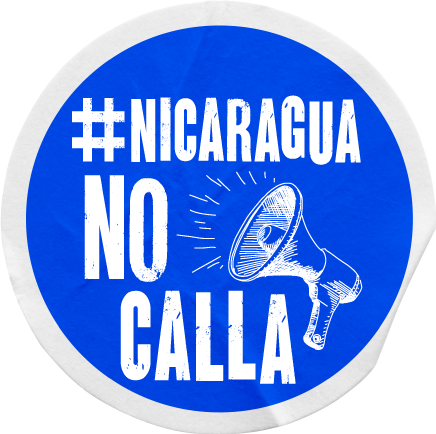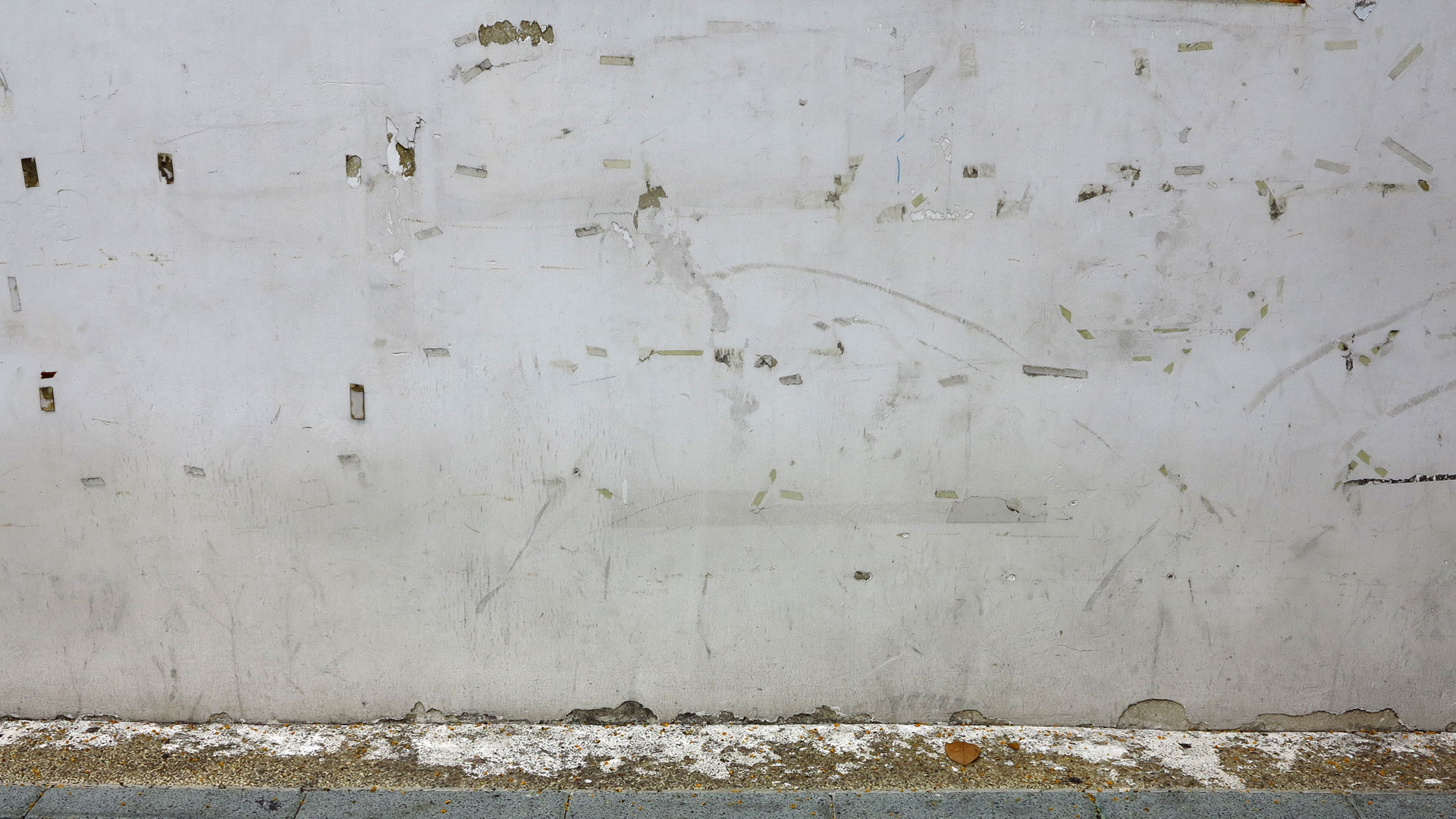90 percent of the city halls in the Central American country are ruled by the governing party, which gives priority to Daniel Ortega’s agenda on top of the true needs.
At the pro-government ones, they finance popular works such as baseball parks, under opaque conditions, while the opposing ones weaken.
A citizen from Masaya passes in front of a banner paying tribute to youngsters killed during somocismo, being among them, Camilo, president Daniel Ortega’s brother. People in this place have denounced current repression
Photo\Connectas

A week after the mayor of Masaya vanished from a public act, vice president Rosario Murillo informed, making a slight reference at her daily broadcast through the government media on June 1st, 2020, that the official, Orlando Noguera, had died.
The decease called the public attention now that Noguera — pointed to human rights violations during the opposing protests in 2018— was an outstanding member of the sandinism. The supposed cause of death was covid-19, and his name was added to a list of high-ranked Sandinistas who died for the same cause in different areas of the country while the government formally minimized the pandemic.
For the city hall in Masaya, a city at the west of Managua, Noguera’s death confirmation meant choosing a replacement. The promotion was entitled to the deputy mayor Janina Noguera under the law; nonetheless, the replacement came from another area of Nicaragua: David Chavarria was sent by the presidential couple to take the municipality on after being involved in administrative tasks at the same commune.
“That man is not even from Masaya. He is from Nueva Segovia (at the North of Nicaragua), and was sent by la Chayo (Rosario Murillo) in 2018 to assume the management of the city hall”, tells Yohana Ramirez, a councilwoman from the Constitutionalist Liberal Party (PLC) in this city, one of the collaborationist organizations of the government at the high-political level who though holds in the interior critics from the Executive as is the case of this official.
To Ramirez, what happened in Masaya with the enforcement of the central government is a paradox because during the FSLN it was opposition, between 1990 and 2006, and was characterized by taking the chance for decentralizing in contrast to the style of handling things nowadays.
The situation in Masaya, with slight nuances, is similar to that in Managua, the capital city, where the formal mayor Reyna Rueda’s mandate co-exists with the power of Fidel Moreno, political secretary of the FSLN in Managua and one of the political operators that presidential couple most trust, who officially is the general secretary in this commune.

Mayor of Managua, Reyna Rueda, shares duties with the general secretary of the City Hall, Fidel Moreno, one of the trustworthy men of the first couple.
Photo\Courtesy
According to a notarized document, published by La Prensa newspaper in 2011, Moreno has two administrative duties after Rueda’s predecessor, Daisy Torres, “entrusted” him the assignment of signing contracts in 2009. Today, he supervises works in the municipality and is the public face of a housing massive program contemplating that potential beneficiaries may access such if they write to Ortega make the request.
In some elections denounced as irregular by a national election monitoring body in 2017, the FSLN took over 135 city halls, but adds up two more now(Wiwili and Mulukuku), after legal decisions that the FSLN interfered according to the complainants. With these last two, the control reaches 90 percent of the del local government, formed by 153 communes, fulfilling the enforcement of the presidential agenda in the localities.
The growth of the FSLN at the local government started in 2008, through the election process rightly hindered. At the time, the civic body Ethics and Transparency explained that in that year, for example, 33 city halls ended up governed by the FSLN after the opposition was ahead in the vote counts in each of them.
FBeing at either local, regional (at the Caribbean Coast), or presidential elections, the irregular pattern in favor of the FSLN was kept. In the elections of 2011, during which Ortega looked for the re-election making use of a sentence that allowed him to run despite the constitutional ban, the Organization of American States (OAS) and the European Union (EU) pressed charges.
“It is surprising to me, that the SEC (Supreme Electoral Council) had put too many obstacles and inexplicable, at times. I don’t know why so many obstacles, so much lack of transparency, and so many tricks in a process that should be fair and transparent”,denounced at the time Luis Yanez, EU Chief Observer.
In 2012, the year of again municipality elections, the government party triple he number of council members thanks to the congressional majority obtained in 2011. This was considered another major blow to the municipal autonomy. At the time, OAS re-emphasized the need of improving the system, but Ortega kept moving forward with his authoritarian project and then retained 127 out of 153 city halls. Five years later he obtained 135, leaving only 18 for the opposition. He afterward added the two more they seized through legal maneuvers, and have developed a relationship with the local government that has swung between the carrot and the hit depending if those governing are from the ruling or the opposition parties.
Screening the municipal transfers to 14 city halls from Nicaragua allows to set a pattern from the Executive benefits the Sandinista ones, and undermines the opposing ones. To come to this conclusion, CONNECTAS looked over a group of seven municipalities currently ruled by the opposition but were managed by the FSLN during the former period (2013-2017). In this case, Finance authorities reduced transfers by half since 2018, the year in which the crisis deepened after the repression, as the charts show.
Other seven-city halls were looked at as the FSLN has stayed in power during the same period, and they represent 42 percent of the urban population in the Central American country. The budget was not cut for then in 2018, in contrast to what happened to those who previously were from the opposition. In 2019 they were cut —as a consequence of the economic crisis that affected finances nationwide—, but it was between 63 and 66 percent, less than that at the opposition ones (between 68 and 75 percent).
Budget squeeze at the opposing ones
In 2018, the amount per capita transferred via budget to the city halls was reduced by nearly half for those in which the opposition won in 2017, but the budget cuts were less than 5% for those who remained with the officialdom.


There is a difference in the treatment given by the executive to the city halls like Leon, Masaya, and Nagarote, all in the hands of the FSLN, despite the crisis the country is undergoing since 2018.
This is a policy that benefits the city halls ruled by its party.
Despite the economic crisis, the most populous Sandinista municipalities facing an electoral year prioritize very popular works like stadiums and other sports complexes. This measure is explained as those were the territorial areas mostly affected by the citizen’s protests in which their majors lead repression, according to a report from the OAS. The Inter-American Commission on Human Rights(CIDH) said repression caused the death of 328 people.
This decision is in contrast to the urgent demands that the localities in these seven municipalities, which have worsened at the Central American that is going through its third year of recession and a cumulative fall that will overcome the ten percent of the GDP. According to economists, this leads Nicaragua into a time of economic downturn. The second one in less than four decades, both arising during periods of Daniel Ortega’s governments, who first run the country during the 1984-1990 period.
It is unsuccessful to reach the majors’ representatives, grouped in the Asociacion de Municipalidades de Nicaragua (AMUNIC), despite the request sent to the majors from Esteli and Matagalpa, both Sandinista.
If they have achieved to approve their agenda is because of the control they have over the city councils. The buildings exist in the ruling party's communes right in the year when the population has been impacted by the pandemic and under conditions of lack of transparency. That is the case of the stadium in Masaya, where US$231.000 was registered in the budget into the “renovation” concept and, afterward, was announced the construction of a new one, without knowing the funding sources.
Carlos Brenes, one of the opposing council members in Masaya, the city where the renovation and later substitution of the Roberto Clemente stadium were planned, assures that there are constructions that have been taking place for many years without knowing why or how the budgetary allocation was set.

The city of Nagarote is 37 km from Managua and is under the ruling party's control.
“They prioritize those that work as propaganda for the government. Even when they inaugurate them, they don’t do it on behalf of the municipality, but on Daniel’s (Ortega) and Rosario’s (Murillo) partners”, explains Brenes, member of the Constitutionalist Liberal Party (PLC).
In the city of Nagarote, at the West of Managua, the main construction is a boulevard. The opposing councilman Nicolas Narvaez Noguera considers a problem that these types of buildings are not initiated, and are included again the following year having no explanation from the managers’ side.
Narvaez gives details on the assignment of US$ 44.000 for the boulevard in 2018, the following year the increase was to US$ 52.000, and this year It was US$77.000 after a budgetary reform. It calls his attention that ornamentals and gardening supplies at a cost of almost US$22.000 are included in the purchase program.
“That is the reason why we demand for the minutes to know what is happening but since 2018 the opposing council members have no access to a minute. In each session of the Council, when the time to read the previous minutes and ask for the approval signature to all the members of the Council comes, they take advantage of them being a majority to work around this point in the agenda; and in the execution reports they can inform anything, and we neither see them as well”, said Narvaez, who agrees that the Sandinista priority is to finance visible works to benefit the party electorally.
Orlando Corea Mendoza, an opposing councilman in the city of Leon, at the West of Nicaragua, regrets that being a minority they can do nothing. If they oppose the Sandinista work plan “they slandered us. They tell people that we oppose to the city’s progress and that the works are for the benefit of the most vulnerable”.


The main works planned by the city hall of Leon is the baseball stadium of the city.
The Sandinista majority in the city councils (2017-2022)
Dayra Valle, Nicaraguan expert on budgetary topics and representative of Transparencia Nicaragua, criticizes the local-level secrecy of this financial operation, causing the inability to verify how the public funding is used.
“The money can easily be diverted away. Because accountability is missing, thereby, transparency and control mechanisms are also missing. Because we know well that the Comptroller per se greatly overlooks the central government institutions; and is in even bigger debt with the municipalities”, Valle says.
The expert appoints the responsibility of the municipal assessments committees as well, being in charge, in theory, of the audit. Contrary to these transparency regulations, what can be seen is a “wide discretion” and “arbitrariness”.
Maximo Morales, a councilman from the PLC in the city hall of Larreynaga, explains that “vertical guidelines are met at the municipalities. Even the Sandinista bench meets several days ahead, and when the official session of the Council takes place, they have already taken decisions. Though we oppose or claim, decisions have already been taken”.
The most important work from the Annual Program of Hirings (PAC) of Leon is also the renovation of the baseball stadium. For this works US$ 2.88 million were allocated during the administration of Sandinista Roger Gurdian. Nonetheless, some weeks ago a transfer of the complex’s administrative responsibilities was done to the baseball professional league team management of the city through a donation.
“From now on, they are responsible for all the expenditures and maintenance so that operation continues. The money allocated for the renovation was used for buying the land and start the construction of a new one that would be ready by the end of 2021”, said Orlando Corea Mendoza, a councilman from Leon, part of the PLC as well.

During the election period at the fullest, some city halls run by the Front supported the construction of stadiums.
To Correa, the priority should have been the construction of medical centers, more access roads, or the payment of municipal debts; nonetheless, the decision was different: prioritize the sports facilities.
In the North of Nicaragua, in Esteli, the investment is in another type of stadium. One where soccer is the king of sports. The investments, in this case, add up millions of dollars. According to the PAC 2020, US$ 602.000 was allocated to replace the artificial turf and almost four million dollars for infrastructure improvements. Behind all this investment is hiding Fidel Moreno, the most powerful man in the city hall of Managua.
Moreno is originally from Esteli and led the city’s team management, whose headquarters are at the Independencia Stadium where the municipal investment is made. The official left his position in the team just until August 2018, when the United Stated penalized him with the Global Magnistky act which is enforced on foreign citizens accused of human rights violations and corruption. Among immediate effects, is that of prohibiting making banking transactions.
Edgard Tijerino, Nicaragua’s best-known sports writer, doesn’t believe that making stadiums is a strategy that favors the FSLN.
The reporter was sports minister during the first Sandinista government in the eighties, and now he is a critic of Ortega. He assures that several sports sites recently inaugurated, such as Alexis Argüello gym, and a swimming pool complex, and tennis courts in Managua, are held empty. “For that reason, I don’t think they may spark something because if they were appealing to young people they would be held full”, he states.
Bayron Estrada, an ex-political prisoner from Ortega’s government, rejects the political manipulation attempt, and also considers that the population has become more aware that the resources come out of the Nicaraguans’ pockets and not the president’s. “The FSLN failed. Its shift ended, it will be useless to fill the country with stadiums”, argued Estrada.

In the North of the country, road Works are taking place, as in the road between San Juan de Limay and Esteli. Infrastructure works are one of the priorities of the FSLN city halls during this election year.
25 km to the West of the Nicaraguan capital city, in front of the Roberto Clemente stadium that Masaya authorities say they will replace, a group of young people daydreams talking about the changes in the building that counts fifty years of history already.
One of them, doubtless, says that the new colossus “will be as the Dodgers one in Los Angeles”, and expresses hope on the promise made by the council members when they presented the project in this city, ruled by the government party and one of the most affected by the state repression in 2018 with more than 40 persons murdered according to the CIDH.
The old building, from where you can see Masaya lagoon, rises in an area of 17.688 square meters and has a capacity of 4.000 people. These are very modest numbers if compared with the American ones the municipal officials referred to now that they can accommodate 56.000 fans in 352.000 square meters.
However, the reality headstrong of data does not prevent Sandinista officials from keeping the promise of constructing a similar stadium. Tijerino insists that “hay can inaugurate a field every week, and that won’t attract the vote of young people”; and regrets that, due to lack of support, sports in Nicaragua have become a tv matter and, concerning the government intention of attracting young people, the assures that they have been the “the hardest hit by the dictatorship”.

A carriage goes through Masaya streets. It is one of the traditions kept in this city located in the East of the country and Granada.




